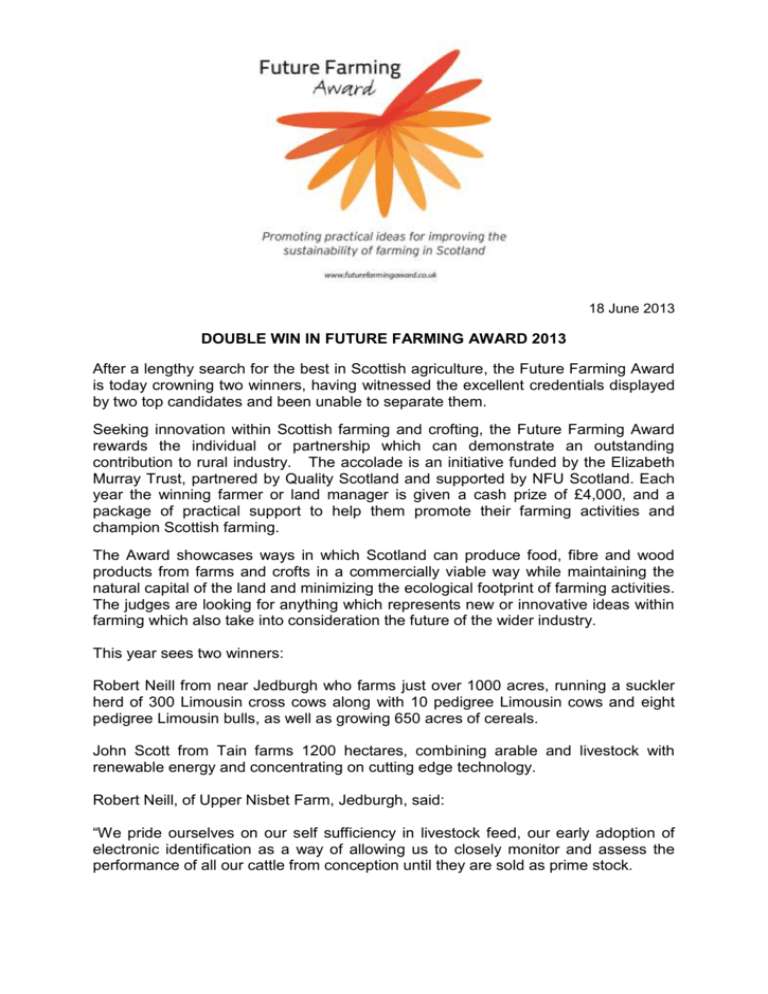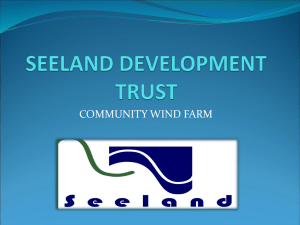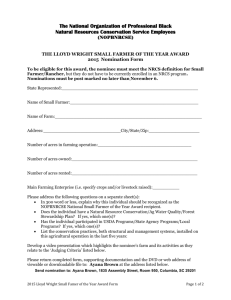18 June 2013 DOUBLE WIN IN FUTURE FARMING AWARD 2013
advertisement

18 June 2013 DOUBLE WIN IN FUTURE FARMING AWARD 2013 After a lengthy search for the best in Scottish agriculture, the Future Farming Award is today crowning two winners, having witnessed the excellent credentials displayed by two top candidates and been unable to separate them. Seeking innovation within Scottish farming and crofting, the Future Farming Award rewards the individual or partnership which can demonstrate an outstanding contribution to rural industry. The accolade is an initiative funded by the Elizabeth Murray Trust, partnered by Quality Scotland and supported by NFU Scotland. Each year the winning farmer or land manager is given a cash prize of £4,000, and a package of practical support to help them promote their farming activities and champion Scottish farming. The Award showcases ways in which Scotland can produce food, fibre and wood products from farms and crofts in a commercially viable way while maintaining the natural capital of the land and minimizing the ecological footprint of farming activities. The judges are looking for anything which represents new or innovative ideas within farming which also take into consideration the future of the wider industry. This year sees two winners: Robert Neill from near Jedburgh who farms just over 1000 acres, running a suckler herd of 300 Limousin cross cows along with 10 pedigree Limousin cows and eight pedigree Limousin bulls, as well as growing 650 acres of cereals. John Scott from Tain farms 1200 hectares, combining arable and livestock with renewable energy and concentrating on cutting edge technology. Robert Neill, of Upper Nisbet Farm, Jedburgh, said: “We pride ourselves on our self sufficiency in livestock feed, our early adoption of electronic identification as a way of allowing us to closely monitor and assess the performance of all our cattle from conception until they are sold as prime stock. “Looking to the future I hope that we can be instrumental in leading the way in terms of using electronic traceability and controlling the health and production of our cattle herd to enable the business to expand its operation for future generations. John Scott, of Fearn Farm, Tain, the second of the two winners, said: “Along with my family and employees I farm 1200 hectares on three sites in the Highlands of Scotland, blending livestock and cropping enterprises with renewable energy and housing whilst using cutting edge technology to farm in a profitable and environmentally sensitive manner. As a team we are always looking for ways in which we can improve what we do and are excited about the future of our industry and the opportunities and challenges that it will bring.” Michael Williams, who runs the Future Farming Award, said: “I have always been proud to be involved in Scottish farming and meeting our two Future Farming Award winners this year has further cemented in my mind the importance of farming as the key foundation of our small country. “Both Robert and John really shone when I met them because they demonstrate how farming can be successful from both a commercial and an environmental perspective. They are both forward thinking, passionate and dedicated to the farming industry both now and in generations to come. Coming from opposite ends of Scotland, Robert and John truly demonstrate the breadth of farming talent across the whole of Scotland and I am delighted that we are rewarding them via the Future Farming Award 2013.” Dave Bradley, Chief Executive at Quality Scotland, partners to the Award, stated: “We at Quality Scotland are exceptionally proud to be partners with the Elizabeth Murray Charitable Trust in promoting Future Farming. At a time when renewables seem to be top of the Scottish industry agenda I am pleased that we are supporting this traditional industry in promoting innovation and excellence and showcasing best practice from our best farmers. “We congratulate Robert Neill of Upper Nisbet Farm and John Scott at Fearn Farm, the 2013 Future Farming Award Winners.” Those wishing further information www.futurefarmingaward.co.uk on the Award can visit NOTES TO EDITORS Photographs of both winners attached About the winners: Robert Neill Robert and Jacqueline Neill took over the tenancy of Upper Nisbet farm, Jedburgh in May 2000. It is part of the Lothian Estate which is owned by Lord and Lady Lothian. The farm originally stretched over 830 acres but in November 2000 they took over another 170 acres on a neighbouring farm. Then in May 2007 another 100 acres were added when another neighbour retired. Another 200 acres of seasonal grazing is also rented on a neighbouring farm. The Neills employ two full time members of staff and a part-time student. The beef enterprise is based on 300 Limousin cross cows which are put back to a Limousin bull. All the progeny are finished on the farm using home grown produce. The steers are sold at any point from 14 month old up to 24 months and the heifers from 18 to 24 months. The Neills place primary importance in the health of their herd, operating a closed herd (with the exception of stock bulls) and screening animals as part of the SAC Premium Health Scheme. All animals have also been voluntarily electronically tagged since 2007, enabling data capture and better stock management. On the arable side, the Neill’s grow about 650 acres of cereals with crops of winter barley, winter wheat, spring barley and beans and also look after 350 acres of cereals for a neighbour. In 2011 they also became one of SAC’s Climate Change Arable Focus Farms. This is a three year study which will involve a number of meetings being held on farm or locally to discuss the ways in which farmers can minimise their environmental impact. With a growing world population, the Neills are confident there is a good future for the beef industry in Scotland. But improving efficiency and reducing costs will be vital to maintain profitability. The Neills are keen to ensure that they offer a sustainable business for their two sons if they decide to become farmers. Robert is also a director of the Royal Highland Education Trust and is keen to encourage youngsters to visit farms to understand where and how their food is produced. Robert has recently been awarded a Nuffield Scholarship. During the next 12-18 months he will spend time travelling to Canada, Australia and South America to study Cattle EID (electronic identification). John Scott John Scott is a sheep, beef and arable farmer from Easter Ross in the Scottish Highlands. He is the fourth generation of his family to farm at Fearn; he farms in partnership with his parents James and Janet and wife Fiona; and has four young children, James 11, Izzy 9, Lexie 7 and Archie 5. Fearn is just over 1000 acres, and is a low lying owner occupied farm near Tain in Easter Ross; they also rent a 300 acre nearby grass hill and have just rented another 700 acre grass block near Helmsdale in Sutherland. The Scotts employ one full time member of staff out with John and and his father, two self-employed men and various seasonal workers helping when required - often from New Zealand. The Scotts find that the New Zealand approach suits their farming style but are also keen to encourage local youngsters to follow a career in agriculture and so work closely with Tain Royal Academy helping with their rural skills course. The farm produces performance recorded rams for their own on farm ram sale from a flock of 200 stud Texel and NZ Suffolk ewes. They have two main aims for the sale and both are equally important, 1. Create an event where people can come along and enjoy themselves whether they are buying or not. 2. Sell as many rams as possible at reasonable money. The other side of the sheep enterprise revolves around prime lamb production from 3500 ewes, producing prime lambs sired by mainly own ram lambs which are finished on high clover content grasses with minimal supplementary feeding. Beef Shorthorns and Aberdeen Angus cows are farmed alongside some crossbreds, producing bulls for sale on farm or at the breed sales in Stirling. Winter barley is grown as an entry for stubble turnips and to provide feed barley for and straw for livestock. Spring barley is grown for malting and where possible stubble turnips are sown afterwards to provide winter feed for sheep. Doing this helps with fertility for the following crop reducing artificial fertilizer requirements. Ground is also let out to a local potato grower who has built a cold store on land adjacent, powered by recently erected wind turbines in an arrangement that benefits both parties. The farm is also in the midst of an SRDP environmental scheme which will see 3000m of hedging planted amongst other wildlife enhancing measures which will be completed this year. John sits on the board of Quality Meat Scotland where he chairs the lamb marketing strategy group, this gives me an opportunity to give something back to the industry. The Scott family see themselves as custodians of the land with a duty to hand it over in as good if not better heart than they inherited it. About Quality Scotland Quality Scotland is a charitable organisation that promotes Business Excellence across Scotland in the private, public and voluntary sectors. As a member-based organisation, Quality Scotland was established in 1991 to help organisations throughout Scotland achieve and be recognised for Excellence, and in doing so, gain real and sustainable competitive advantage. Quality Scotland's vision is to make Business Excellence a national characteristic. We help organisations adopt a holistic approach to understanding their strengths and areas for improvements. As the National Partner Organisation for EFQM, the most widely used management framework in Europe, we are the accredited body for using and applying the Excellence Model in Scotland. Quality Scotland promotes a series of Europe-wide recognition schemes designed not only to celebrate success but that give detailed feedback that can then be incorporated into business improvement plans. This programme is known as Levels of Excellence and is open to organisations from any sector as well as individual business units. Levels of Excellence are based on the EFQM Excellence Model, and recognise organisations at various milestones on their excellence journey. Ends







